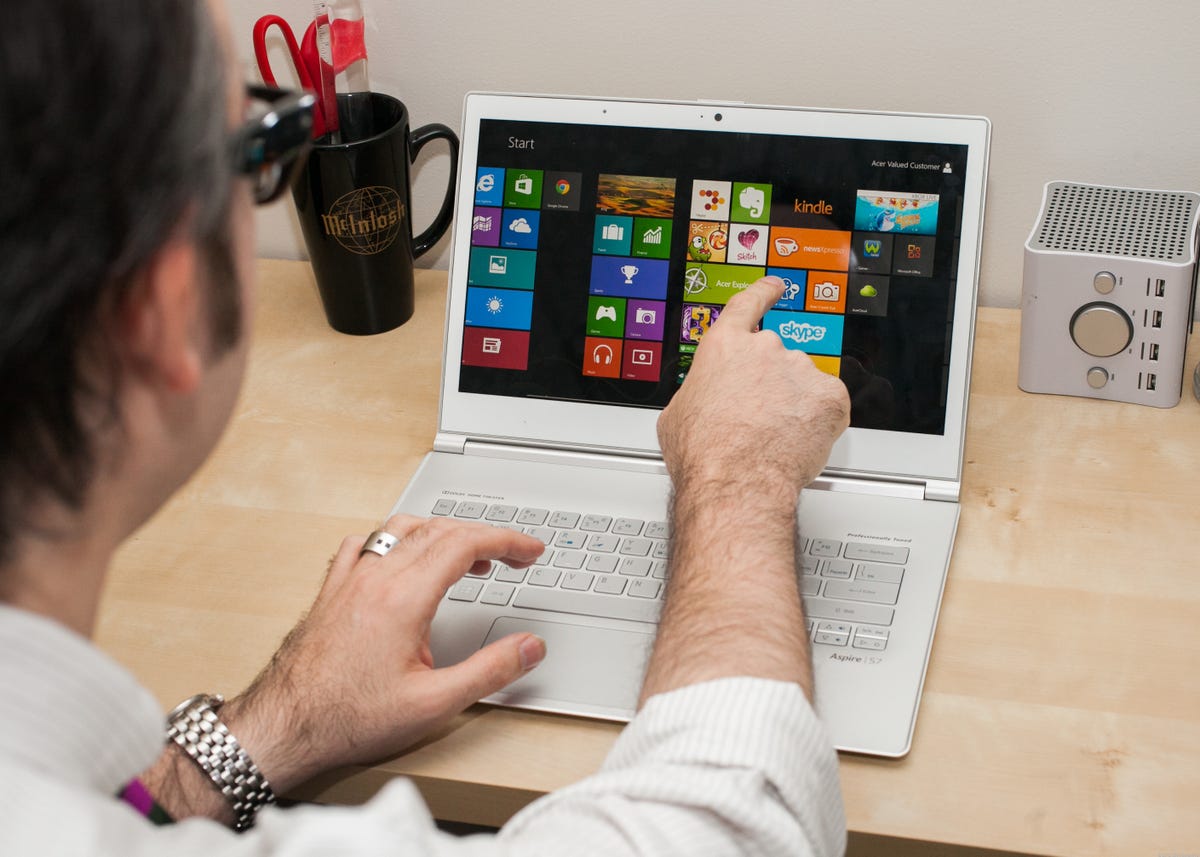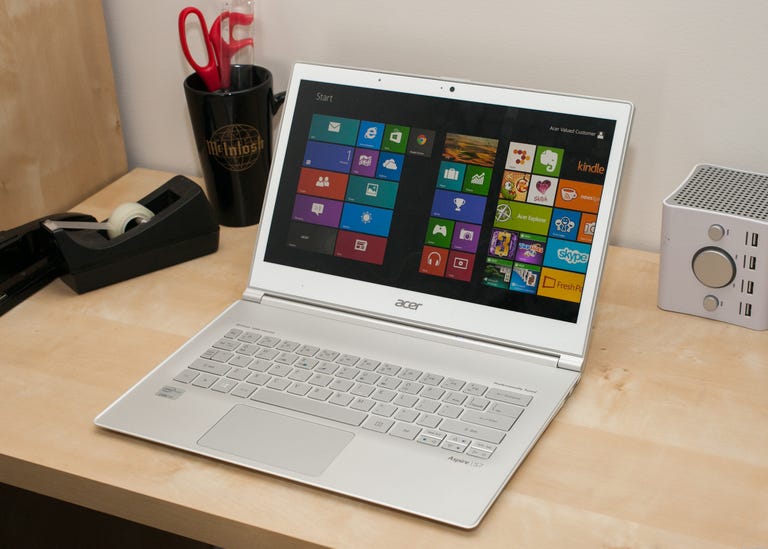 Why You Can Trust CNET
Why You Can Trust CNET Acer Aspire S7 review: Windows 8 in premium touch-screen design
This was one of the first Windows 8 laptops we profiled; now read the full review.
The slim, premium-feeling Acer Aspire S7 was one of the very first Windows 8 laptops I spent a significant amount of time with in the weeks before the official release of Windows 8. My colleagues and I agreed at the time that this 13-inch touch-screen laptop was an excellent advertisement for Microsoft's new OS, but our demo unit was preproduction hardware, and not ready for benchmark tests. Now, with a final consumer-ready version of the same machine in-hand, we can report performance and battery life test results and give this excellent laptop a review score.
The Good
The Bad
The Bottom Line
In hands-on use, this Aspire S7 looked and felt identical to the preproduction sample from October 2012. Like many of the laptops and convertible laptop/tablet hybrids we've reviewed recently, the Aspire S7 is a new-from-the-ground-up ultrabook, rather than an existing Windows 7 product updated with new software. The S7 is also one of the thinnest, slickest-looking ultrabooks I've seen, highlighted by a white minimalist chassis and a lid covered with Gorilla Glass (much like the HP Envy Spectre). Inside is an Intel Core i7 CPU and something that has already become almost commonplace in Windows 8 laptops: a touch screen, built into a 13.3-inch 1,920x1,080-pixel display.

In Windows 8, with its tile-based interface and support for new and varied gestures, the touch screen becomes a useful secondary tool, as seen here, or in systems such as the Dell XPS 12 or Lenovo Yoga. It's not something you'll use every time, but after a few days, you'll find yourself reaching for it more and more, usually for a quick swipe or to scroll up and down long Web pages.
While the hardware and design of the Aspire S7 is definitely premium, it's a tough sell at $1,649, especially with touch-screen Windows 8 laptops available for as little as $529. An Intel Core i5 version of the S7 is available for a more reasonable $1,399, and your sizable investment gets you a 1080p display, a 256GB SSD, and that excellent touch screen.
| Price as reviewed | $1,649 |
| Processor | 1.9GHz Intel Core i7-3517U |
| Memory | 4GB, 1600MHz DDR3 |
| Hard drive | 256GB SSD |
| Chipset | Intel HM77 |
| Graphics | Intel HD4000 |
| Operating System | |
| Dimensions (WD) | 12.7 x 8.8 inches |
| Height | 0.5 inches |
| Screen size (diagonal) | 13.3 inches |
| System weight / Weight with AC adapter | 2.9/3.5 pounds |
| Category | 13-inch |
Design and features
The Acer Aspire S7 is one of the sharpest-looking laptops of 2012. It's incredibly thin and light, although the glass-covered lid makes it a bit top-heavy. The HP Envy Spectre had a similar glass-heavy design, putting glass on the back of the lid and the wrist rest. Here the wrist rest is thankfully glass-free.
The rest of the body is aluminum. Acer calls it a unibody chassis, much as Apple does, which means the base of it is carved from a single block of material. Its materials and coloring are different from a MacBook, but there's a certain stylistic similarity. However, it's unique enough to provide ample evidence that Apple does not have a monopoly on sharp high-end laptop designs. Several of my colleagues have walked by, seen the S7, and have been very impressed -- that's a very useful metric in an office filled with jaded reporters who see every tech device under the sun. Then again, for $1,600, this had better be an impressive piece of hardware.
The keyboard has flat-topped, island-style keys, but it's hampered by extremely shallow key depth. I found myself making a lot of typing mistakes, because I had a hard time figuring out on the fly if each keystroke had registered. It's a long-standing issue with many of the thinnest ultrabooks (and a few not-so-thin ones). While it didn't make the keyboard unusable, this was not my favorite typing experience in recent memory.
The touch pad is a decent size for such a small laptop, but it's not among the most responsive I've tried. It's an Elan touch pad, rather than one from Synaptics, a company we've spoken to extensively about its ambitious Windows 8 touch-pad hardware and software plans. I found myself reaching for the touch screen more often than I might have because of the sluggish response.
The optimal way to interact with a Windows 8 laptop such as the Aspire S7 is through a combination of the keyboard, touch pad, and touch screen. It's a concept rarely seen before that has surprisingly become standard for Windows 8 laptops almost overnight, with touch models from Dell, HP, Acer, Asus, Toshiba, Sony, Lenovo, and others. It's too early to tell if this will be the new standard for all laptops, but so far we've seen only a handful of review samples without a touch screen, and prices have come down below $600 for basic models with Intel Core i3 CPUs and touch screens. If it can be added without a significant cost increase, I suspect a touch screen may be the new normal in 2013.
To be fair, it may be that the touch screen seems like the optimal way to interact with Windows 8 because touch-pad and keyboard controls are so incredibly counterintuitive. Swapping among programs, viewing all the programs you have open, and even switching among Web browser tabs are all a hassle in Windows 8, unless you have a touch screen, in which case a simple flick performs most basic system navigation tasks. The touch pad can mimic those moves, but it's not nearly as easy to do.
I found myself, without much deliberate planning, reaching out and using the touch screen for some tasks, while using the touch pad and keyboard for others. Having a touch screen on a laptop isn't a necessity, but having consumers trained for years now with smartphones and tablets, it's a much more natural interaction than it would have been in previous generations of hardware.
Helping solve one particular touch-screen laptop issue I've encountered before, the Aspire S7 screen hinge acts as one would expect from the closed position to about 120 degrees or so. After that, the hinge stiffens considerably. The end result: tapping and swiping on the screen while the laptop is open does not result in as much shaking or movement as you would expect. The screen also opens up to a full 180 degrees, allowing the system to lie completely flat, not that that's the kind of thing you would normally do.
The screen itself has a full 1,920x1,080-pixel resolution, which is a great premium feature to have on a 13-inch laptop, and at least part of the reason this system is so expensive. Many PC makers have told me that adding touch to an ultrabook screen will add some thickness, but in this case, the lid still seems very thin, with decent off-axis viewing and a screen that's glossy, but not overly reflective.
| Acer Aspire S7 | Average for category [13-inch] | |
|---|---|---|
| Video | Micro-HDMI | HDMI or DisplayPort |
| Audio | Stereo speakers, combo headphone/mic jack | Stereo speakers, headphone/mic jacks |
| Networking | 802.11n Wi-Fi, Bluetooth | Ethernet, 802.11n Wi-Fi, Bluetooth |
| Optical drive | None | DVD burner |
Connectivity and performance
With such a small laptop, it's inevitable that some features get skipped or otherwise compromised. In this case, it's the video output, which consists of a single Micro-HDMI port. You'll need an adapter to use it, whether you're sending the signal to an HDMI device or converting it for a VGA input. Besides that, you get two USB 3.0 ports and an SD card slot, which makes the S7 passable, but not particularly impressive, for connectivity.
I tested the more expensive of two Aspire S7 13-inch configurations (there's also an 11-inch model). This $1,649 configuration has an Intel Core i7-3517U processor, plus 4GB of RAM, and a 256GB SSD. For $1,399, you can trade down to a Core i5 CPU and a 128GB SSD -- in either case, this is an expensive laptop compared with other models with comparable specs.
In our benchmark tests, the Aspire S7 and its Intel Core i7 CPU were near the top of our Windows 8 ultrabook results. Still, in some cases, it didn't offer a significant advantage over similar systems we've tested with Core i5 processors. In anecdotal use, just like the preproduction model I previously tried out, the S7 performed very well, and always felt fast and responsive, even when using the touch screen. It's certainly more power than you're likely to need, and even the Core i5 version should be fine for Web surfing, social media, office productivity, and HD video playback.
Some have complained that Windows 8 is not ideally suited for playing games. They could be right, but I was able to install and load up Steam with no problem, and played Call of Duty: Modern Warfare 3, albeit with the graphics options turned well down. With only Intel's integrated HD 4000 graphics, this isn't going to be your main gaming rig, but it will be interesting to see if anyone can make good use of the touch screen for casual games.
With such a slim body, and powering a touch screen as well as a Core i7 CPU, it may be too much to expect stellar battery life from the S7. Still, the current generation of Intel Core i-series CPUs have helped all sorts of ultrathin laptops post impressive battery scores, and a short-lived 13-inch laptop is now the exception rather than the rule. The S7 was impressive, even by those standards. It ran for 6 hours and 26 minutes on our video playback battery drain test, more than other higher-end ultrabooks, but behind the similarly priced new 13-inch MacBook Pro with Retina Display.
Conclusion
So many of the Windows 8 laptops to date have been either painfully similar, shamelessly cloning each other, or else overly complicated convertible tablets that twist, flip, or swivel. The Acer Aspire S7 is priced out of the range of most laptop shoppers, but it looks great, runs well, and, most importantly, serves as an excellent proof of concept for both Windows 8 and touch-screen laptops.
(Shorter bars indicate better performance)
(Shorter bars indicate better performance)
(Shorter bars indicate better performance)
(Longer bars indicate better performance)
(Shorter bars indicate better performance)
Find out more about how we test laptops.
System configurations:
Acer Aspire S7-391-9886
Windows 8 (64-bit); 1.9GHz Intel Core i7-3517U; 4GB DDR3 SDRAM 1,333MHz; 128MB (Shared) Intel HD 4000; 256GB Intel SSD
Lenovo IdeaPad Yoga 13
Windows 8 (64-bit); 1.7GHz Intel Core i5 3317U; 4GB DDR3 SDRAM 1,600MHz; 32MB (Dedicated) Intel HD 4000; 128GB Samsung SSD
Sony Vaio T13
Windows 8 (64-bit) w/ SP1; 1.7GHz Intel Core i5-3317U; 6GB DDR3 SDRAM 1,333MHz; 32MB (Shared) Intel HD 4000; 500GB Hitachi 5,400rpm
MacBook Pro 13-inch Retina Display (fall 2012)
OSX Mountain Lion 10.8.2; 2.5GHz Intel Core i5 3210M; 8GB DDR3 SDRAM 1600MHz; 768MB (Shared) Intel HD 4000; 256GB Apple SSD
HP Envy 4-1102
Windows 8 Pro (64-bit) w/ SP1; 1.7GHz Intel Core i5-3317U; 4GB DDR3 SDRAM 1,600MHz; 32MB (Shared) Intel HD 4000; 500GB Hitachi 5,400rpm


